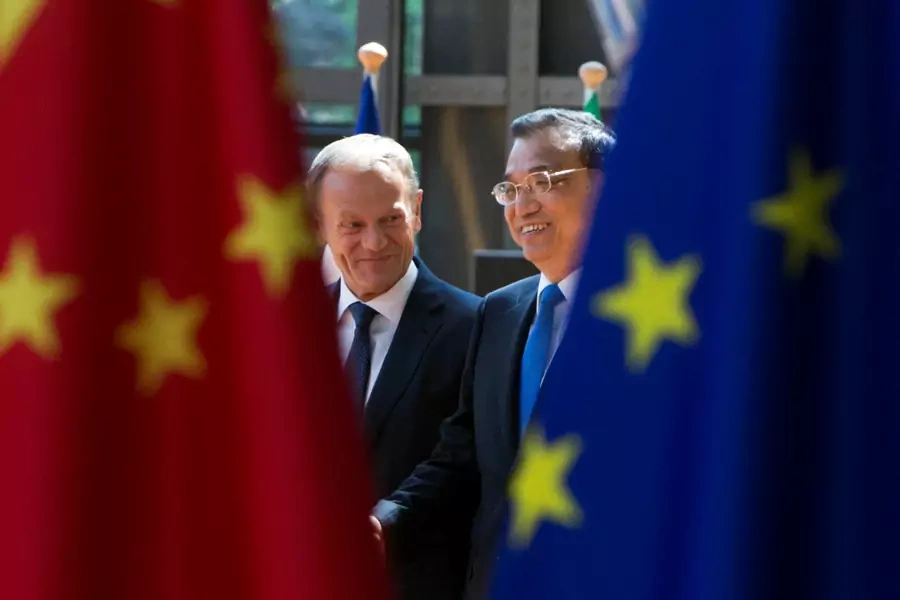Trading Places: How the EU-China Summit Underlined U.S. Isolationism in Trade Under Trump

Coauthored with Ashley Feng, research associate in the international institutions and global governance program at the Council on Foreign Relations.
As the rest of the world is distracted by President Donald J. Trump shredding the transatlantic alliance and groveling to Russian President Vladimir Putin, China is taking advantage of the distractions to burnish its own claims of leading the international trading order. In the days leading up to and after the NATO summit, China has met with many of the United States' traditional transatlantic partners. This culminated Monday in the annual European Union (EU)-China summit.
More on:
This is a remarkable turnaround in China’s image. This is the same nation, after all, that has continuously stolen trade secrets and intellectual property from western firms, restricted foreign investment in its domestic sectors, and refused to fully implement its World Trade Organization (WTO) accession agreement. What has made China appear to be a reasonable actor is international outrage at U.S. unilateralism. U.S. protectionism isn’t just limited to China. The United States has also imposed steel and aluminum tariffs on its closest friends and allies, including the EU.
Trump’s reckless economic strategy is allowing China to present itself as the savior of the global trading system, while depriving the United States of the partners it needs to make common cause against Chinese mercantilism.
The administration’s scattershot approach undermines the WTO and shifts the spotlight from predatory Chinese practices to its own rash behavior. Recent speeches by Chinese President Xi Jinping and Chinese propaganda have amplified China’s claims that it is a defender of the liberal trading order—a position to which the EU has now given tentative support.
In their joint statement concluding the EU-China summit (the first in two years), both sides expressed strong support for “the rules-based, transparent, non-discriminatory, open, and inclusive multilateral trading system with the World Trade Organization (WTO) as its core.” The statement echoed the joint declaration that Germany and China released just before the summit. Titled “Responsible Partners for a Better World,” it “rejected all forms of protectionism.”
U.S. actions haven’t just hurt countries abroad. Attacking foreign companies and imposing tariffs on imports have also made the United States a less attractive place in which to do business. During the first quarter of 2018, foreign direct investment (FDI) flows into the United States decreased by almost 40 percent compared to 2017 levels. Increasingly, countries and companies looking for investment opportunities may turn toward China. In its latest economic and trade dialogue, the EU expressed interest in speeding up negotiations on an EU-China bilateral investment treaty, shutting out U.S. businesses.
More on:
While the United States continues to close itself off and pulls apart global supply chains, other countries are moving on. The day after the Trump-Putin summit in Helsinki, Japan and the European Union signed a free trade agreement that covers a third of the global economy. The Pacific Alliance, composed of Chile, Colombia, Mexico, and Peru, is also in talks with Canada, Australia, New Zealand, and Singapore to sign a multilateral FTA, launched six months after Trump announced the U.S. withdrawal from the Trans-Pacific Partnership (TPP).
In Southeast Asia, countries are in a bind. They are dependent on exporting intermediate goods to China, which are then exported as finished goods to the United States. In order to avoid choosing between the world’s two largest economies, they are trying to increase intraregional trade. The result will be to stabilize their own supply chains, but this will put U.S. economic interests at a long-run disadvantage.
In enacting unilateral trade penalties, the United States—a founder and defender of the WTO—now faces the likelihood that both the European Union and China will bring cases against it within that body. There have even been rumors that the United States will pull out of the WTO—abandoning the system that it helped build.
Withdrawing from the WTO would be a critical mistake—the trade equivalent of an own goal in soccer. The United States is the most frequent complainant in the WTO dispute settlement system, where it has won over 90 percent of the cases it has brought. Instead of tearing apart the organization, the U.S. should continue working with like-minded partners like the EU and Japan to improve the system.
Countries don’t want to have to choose between the U.S. and China. Until now, the European Union has resisted forming an anti-U.S. alliance with Beijing. But this forbearance may not last. If the United States continues to pursue its reckless trading strategy, the other players in global trading system will shut it out and move on.
 Online Store
Online Store